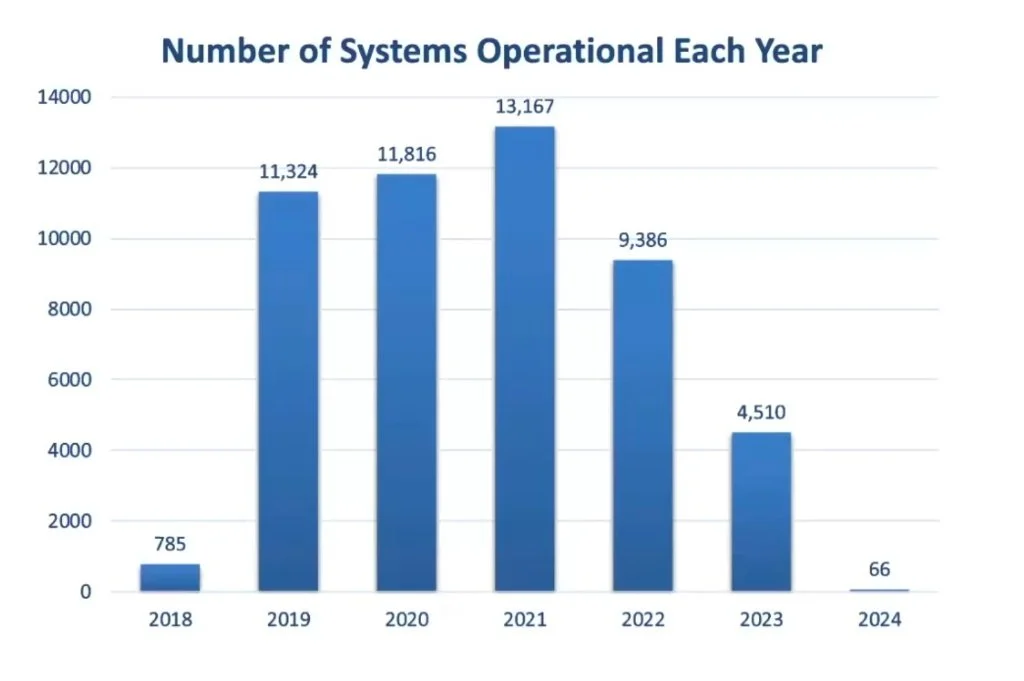Decoding Massachusetts SMART 3.0: A New Era for Battery Storage
Massachusetts has long been a leader in renewable energy, and its Solar Massachusetts Renewable Target (SMART) program has been a cornerstone of that success. Designed to incentivize solar development, SMART has continuously evolved to meet the changing needs of the grid and the renewable energy landscape. Now, with SMART 3.0 on the horizon, a new focus on intelligent battery storage is taking center stage.
Our team at Utilized Energy has been at the forefront of this evolution, providing expert battery consulting services for dozens of projects across Massachusetts. We've witnessed firsthand the program's successes and challenges, and we're excited about the opportunities SMART 3.0 presents for solar developers venturing into the energy storage marketplace.
The Rise and Steep Decline of SMART 2.0 Participation
While the initial run of the SMART program saw tremendous growth in project development, its later stages experienced a significant collapse in participation. This trend, which affects all system types (not just battery storage), highlights the need for the adjustments seen in SMART 3.0.
The following data, illustrating the number of systems becoming operational each year, clearly shows the program's peak and subsequent drop-off:
Source: Massachusetts Department of Energy Resources, "Creating a Clean, Affordable and Resilient Energy Future for the Commonwealth," Slide 42.
The drastic decline in operational projects after the 2021 peak, leading to a nearly non-existent pipeline by 2024, was driven by a confluence of factors, including:
Declining Incentive Rates: The SMART program's original declining block structure meant compensation rates fell as capacity was utilized, eventually making many projects uneconomic.
Rising Costs and Delays: Significant increases in equipment costs, interconnection costs, and permitting delays created a market environment that outpaced the program's fixed incentive structure.
SMART 3.0 is designed to address this by moving to annual incentive rate adjustments to better reflect the current market reality.
The Evolution of Battery Requirements: From Simple Cycling to Intelligent Dispatch
One of the most significant changes in the SMART program has been the evolution of requirements for battery energy storage systems (BESS), moving the focus from simple verification to sophisticated grid service delivery.
1. The Original Requirement: Simple Proof of Operation (Once-a-Week Cycling)
In the original SMART design, the primary function of the Energy Storage Adder was to incentivize the installation of batteries. The operational requirement for eligibility was relatively basic: systems merely needed to demonstrate a minimum number of discharge cycles per year (initially 52 cycles, or once a week) to ensure the equipment was functional and available. The focus was on ensuring the battery was ready to charge and discharge, not necessarily when it was doing so.
2. SMART 3.0: Intelligent Dispatch and Grid Alignment
SMART 3.0 introduces a fundamental shift toward using storage to provide active, intelligent grid services. The new program structure moves away from simple compliance and directly ties system value to grid needs, specifically through:
Intelligent Dispatch Requirements: While the new regulations are being finalized and detailed performance standards are still evolving, the clear regulatory intent is to require batteries to respond dynamically to grid conditions, focusing on peak shaving and demand reduction. For example, large projects (1 MW and greater) in SMART 3.0 are strongly incentivized to include storage, and the program's overall philosophy demands that this storage provide maximum benefit to the grid.
Direct Overlap with the Clean Peak Credit (CPC) Program: This is the most critical change for BESS economics. The Massachusetts Clean Peak Energy Standard (CPS) created Clean Peak Energy Certificates (CPECs), which reward clean energy resources for discharging power during the highest-demand, highest-cost hours (seasonal peaks).
The Synergy: SMART 3.0 is specifically designed to allow battery storage systems to stack their SMART Adder revenue with CPEC revenues from the Clean Peak Standard and incentives from utility Demand Response programs like ConnectedSolutions.
The New Mandate: This financial overlap means that successful battery operation is no longer about a weekly cycle; it’s about having intelligent dispatch software that can continuously monitor market signals, forecast grid peaks, and automatically discharge during the most critical, high-value hours to maximize the CPEC and DR incentives.
Partnering for a Smarter Energy Future
For solar developers, the shift to SMART 3.0 requires moving beyond simply sizing a battery for a weekly cycle. Success is now dependent on market intelligence and optimization software to harvest the maximum stack of incentives from SMART, CPC, and ConnectedSolutions.
At Utilized Energy, our expertise has been honed through direct experience with dozens of complex projects in this market. We provide the consulting services needed to:
Model and Optimize: Precisely model dispatch strategies to forecast and maximize the stacked revenue from the SMART Adder, CPEC, and Demand Response programs.
Navigate Compliance: Ensure your project meets the evolving regulatory and metering requirements for simultaneous participation in all relevant programs.
Future-Proof Design: Design BESS architecture that is compatible with the intelligent dispatch platforms necessary for dynamic, peak-responsive operation.
The SMART 3.0 program is an opportunity to revitalize the Massachusetts renewable energy market, placing intelligent battery storage at the forefront of the state's clean energy goals. Partner with Utilized Energy to turn complexity into certainty and secure the strongest possible return for your energy storage investment.
